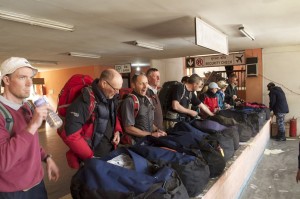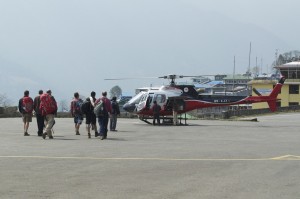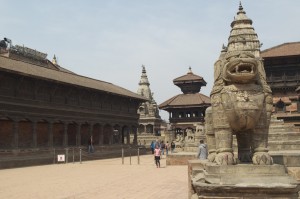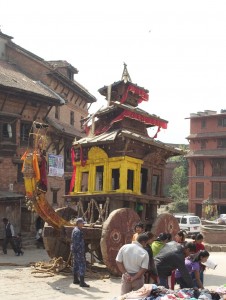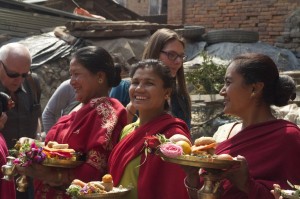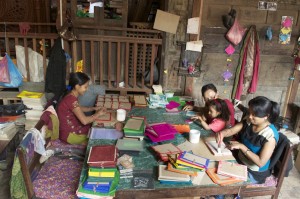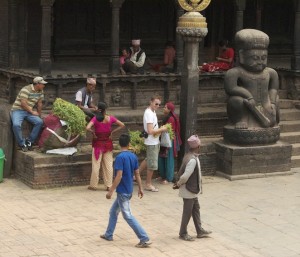Having had one of the best night’s sleep of the trip we had a fairly leisurely breakfast before strolling over to the airport. We discovered that although we were due out on the second wave of Tara flights, we had been bumped on to the third phase. As the morning progresses in Lukla the chances of flying out diminish dramatically as the wind tends to increase, making it significantly more dangerous. To try to ensure our departure, Hira, in Kathmandu, chartered a Sita Air plane to do the job.
Having gone through all the check in and security processes in the expectation of leaving, originally, at 8.30, we found ourselves still waiting at 10.00 with increasing wind. As the group lined up for security, bags opened for scrutiny, Robert started to worry about his two dried yak dung patties he was hoping to take home as a present for his youngest son! He managed to get them through, but will it be the same at Heathrow when the yak dung smelling dog, specifically employed for such occasions sniffs him out. Hopes for our flight out rose as we saw our Sita Air flight approach Lukla, but then fade again as it aborted its landing attempt, banked and returned to Kathmandu. It became clear that there would be no further flights today.
As we walked back to the Paradise Lodge, I bumped into Colin Scott and his family who had been out on Mera Peak. Colin is part of the MEF and is one the organising committee with me for the 60th Anniversary of the First Ascent of Everest. It is such a small world. Only the day before, as we sat in Starbucks, Lukla, I had said I wondered how long I would have to sit there before I saw somebody I knew. Not that long, apparently.
Back at Paradise Lodge we had coffee, pre-ordered lunch and waited to see what the outcome of Tanka ‘s many phone calls was. Eventually, it became very clear that our only chance of getting out in reasonable time was to pay the necessary to charter a couple of helicopters. If we chose to stay another night in Lukla, priority for flights the next day would go to that day’s ticket holders and we would be fitted in, if possible, after they had all gone. The likelihood is that conditions would again interfere and we would find ourselves trapped further in Lukla, jeopardising return international flights. Explaining the situation, the options and the extra $300 cost per person, we put it to a vote. Everybody chose the immediate option of getting helicopters out asap.
More phone calls followed and lunch was served. No sooner had some finished their food than the call came for the first six to go quickly to the airport. The helicopters can take a maximum of six passengers. Very soon afterwards a helicopter landed on the apron, the six climbed aboard and off it went.
The rest of us, knowing there would be some time before it was out turn enjoyed our leisurely yak sizzler before, ourselves heading over to the airport.
Unlike this morning, the place was deserted of security etc. and we sat on the edge of the apron and waited. It took a long time for the second helicopter to arrive, but eventually it did and the second six were quickly ushered aboard and it was off. That just left me with Tanka and Bishnu, who were not planning to return until there was a more cost effective way for them. Others turned up on the apron wanting to get on a flight and it was not much longer for the next helicopter to arrive. I managed to squeeze in the front seat, next to the pilot, with a young lad next to me. It was very cramped but If I could have turned round, I think I would have found it even more cramped in the seats behind.
Helicopters are like bees; in theory they should not be able to fly. This one appeared to be very flimsy. It did give fantastic 180 degree visibility, which you do not get in an aeroplane. Alternatively, it does not go as high as a plane so there were no white peak mountain vistas, just fascinating glimpses, from above, of Nepali rural life. The entire flight took about forty five minutes. The constant vibration seemed to transfer to my chest, which started me coughing. Maybe this is exactly what I needed to clear my chest.
I was soon transported across the airport to be met by Hira’s brother and the second half of the group who had only landed a matter of a few minutes before me.
The Hotel Tibet has an impressive reception area and the rooms are good. There is an adequate outdoor seating area/bar/dining and a pleasant roof garden and bar offering a mixture of sun and shade with pleasant air flow. Sadly the bar and snacks are not available until after 2.00pm. What is lacking are some of the little things that we come to expect, a variety of complimentary soaps and shampoos in the bathroom, a switched on, as well as a well stocked mini bar, free wifi instead of the expensive and irksome system they have in place at the moment. Remarkably, everybody, despite having a fairly inactive day, was feeling tired and, as a group, we chose to stay in the hotel in the evening and sample the restaurant fare. It proved to be a good decision, like the one we had made earlier with regard to getting back to Kathmandu.
The following morning, feeling somewhat refreshed, ten of us were collected at the hotel and taken to Bhaktapur for a half day tour with our guide, Ramesh. I love Bhaktapur. It is so much more pleasant than Kathmandu in that the pace of life is much slower. The people seem more content, happier, with ready smiles whether they are drawing water from a well, selling peas on the vine or pleasantly trying to persuade you to buy a silk purse or a necklace. There isn’t the pressure that Kathmandu seems to impose on everybody. It is great place to sit and people watch.
Ramesh took us the the various temples and gave us a brief résumé of them. I don’t think anybody particularly wanted long, historical details. Having covered the most important temples we we able to concentrate on the more interesting human activity that Bhaktapur is renowned for. Sitting in a small square was the chariot used during the new year celebrations. It is a huge rickety wooden construction built almost in the style of a temple. Crowds of young men clamber aboard as others pull it through the streets. It is such a precarious construction and with the uneven streets it rattles between the houses, often clipping overhanging roofs and causing damage to both buildings and riders, if they are unfortunate enough to be in the wrong place at the wrong time. Used only yesterday, there were two fatalities when participants fell off the chariot and were crushed by its giant wheels. Two fatalities is two too many but there have been times in the past when there have been many more.
We soon found ourselves in the square renowned for its pottery. Whenever I have been there in the past there has been a great deal of activity related to that craft. This year there was none because of the continuing new year celebrations. In one corner of the square there was a gathering of people with a lot of music coming from two or three different musical groups who seemed intent on drowning out the opposition. There was a fabulously happy atmosphere about the gathering as the red saried women presented their sweet gifts to the shrine held aloft on the shoulders of giggling men. Tourists mingled with the groups and you were never given the feeling that you were in the way or imposing yourself upon their event. So much more relaxed than Kathmandu.
Moving on we went to see the peacock window before visiting a paper making factory. This gave us an insight, not only to the skills involved in making paper but also into the working conditions. The building was a labyrinth of staircases and small working areas but the space was crammed with paper and paper products in various stages of production and finished products showcasing the wide range of products on sale. The workers seemed happy and relaxed and one or two mothers had their children with them, presumably because the schools were on holiday and not because they were employing child labour.
It was time for coffee, so we went to the Peacock Cafe, overlooking a square where we spent the best part of an hour people watching from our balcony tables. From here we could watch the women drawing water from the well. Soon after we assumed our lofty lookout a young girl arrived with a large bundle of peas on the vine wrapped in a cloth. She sat on the base stone of a temple and, for a long time, nothing happened. Then, like bees round a honey pot, she was surrounded by people eager to buy her crop. Stephen popped down and bought some. Soon her crop way gone and another woman took over with a similar bundle. For the rest of our time in Bhaktapur, shopkeepers sat in their shop doorways eating peas from the pod.
Our last visit in Bhaktapur was to a wood carving centre. Because it was still festival time no carving was being done but we could look at samples of their work.
Slowly we ambled back to the bus which returned us to the hotel for a late lunch.
In the afternoon I took Stephen and Nathan into Thamel for some last minute shopping.
In the evening we went to the Nepali Kitchen for a traditional Nepalese meal with cultural dancing.
Today had been one of those nothing days waiting to go home. The boys left after breakfast for their flight to Kuala Lumpa, not an enjoyable experience saying goodbye at the best of times but especially when the next time I see Stephen will be some way in the future. I popped into Thamel but had no real reason to be there, so returned to the hotel and spent the rest of the day on the roof terrace.
The group has now gone so it is very quiet. A large part of me wishes I had left with the group but tomorrow is going to be another day with plenty to interest and excite.

